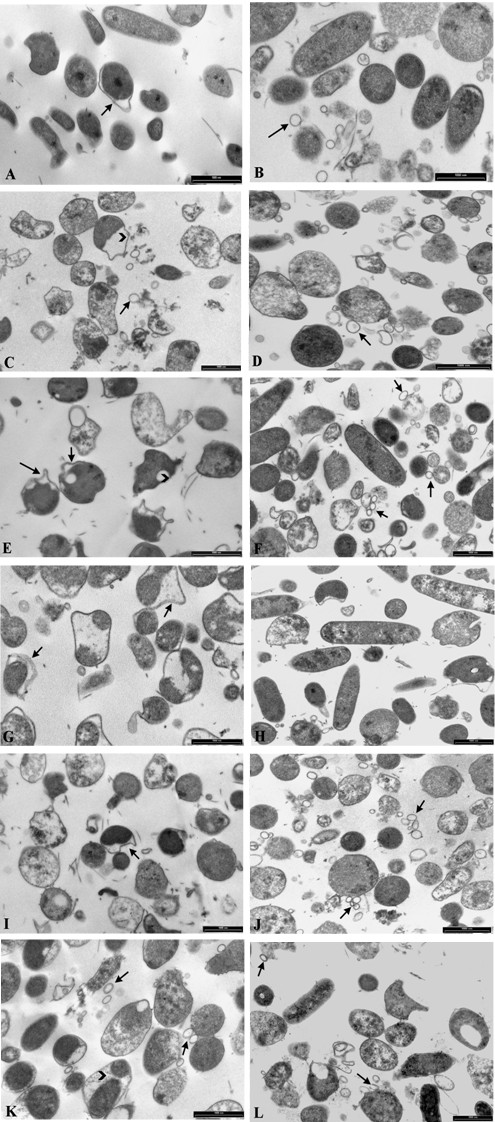Figure 2.

TEM micrographs of CCUG 17874 (A, C, E, G, I, K) and M/C-R2 (B, D, F, H, J, L) H. pylori strains. CCUG 17874 untreated bacteria (Figure 2A) show homogeneous cytoplasm and rare membrane/cytoplasm detachments (arrow). M/C-R2 untreated bacteria (Figure 2B) show homogeneous cytoplasm, flagella and vesicles (arrow). CCUG 17874 bacteria treated with polysorbate 80 (Figure 2C) are swollen and morphologically altered; cytoplasm is granular and detached from the inner membrane (arrow head); vesicles (arrow) are present. M/C-R2 bacteria treated with polysorbate 80 (Figure 2D) are swollen and morphologically altered; cytoplasm is not homogeneous and numerous vesicles are present (arrow). CCUG 17874 bacteria treated with clarithromycin (Figure 2E) show altered shape, typical “holes” in the cytoplasm (arrow head), membrane/cytoplasm detachment (arrows) and fragments of flagella. Some M/C-R2 organisms treated with clarithromycin (Figure 2F) have a conserved morphology, others show granular cytoplasm and altered membranes. Flagella and vesicles (arrows) are present. CCUG 17874 bacteria incubated with metronidazole (Figure 2G) are severely altered and show detachment of cytoplasm, often fragmented, from inner membrane (arrows). M/C-R2 bacteria treated with metronidazole (Figure 2H) are morphologically similar to control. CCUG 17874 treated with polysorbate 80 and clarithromycin (Figure 2I) displays alterations typical of organisms treated with the two substances used alone: swollen cells and detachment membrane/cytoplasm (arrow). M/C-R2 bacteria treated with polysorbate 80 and clarithromycin (Figure 2J) are mostly swollen, their cytoplasm is granular and numerous vesicles are present (arrows). CCUG 17874 strain treated with polysorbate 80 and metronidazole (Figure 2K) displays swollen bacteria, granular cytoplasm, presence of vesicles (arrows) and detachment of fragmented cytoplasm from the inner membrane (arrow head). M/C-R2 bacteria treated with polysorbate 80 and metronidazole (Figure 2L) are swollen; cytoplasm is granular and displays the presence of “holes”. Vesicles are present (arrows). Bars 2A-L: 1000 nm.
